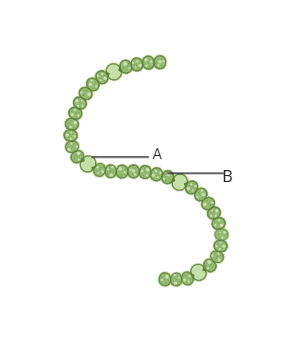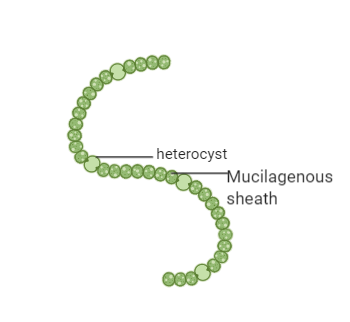
Given figure is of filamentous blue-green alga Nostoc.
Identify the parts marked as A and B and select the correct option.

A - Heterocyst, B - Mucilaginous sheath
A - Vegetative cell, B - Mucilaginous sheath
A - Trichomes, B - Cell wall
A - Mucilaginous sheath, B - Heterocyst

Answer
462.6k+ views
Hint:Blue-green algae or cyanobacteria are capable of fixing the environment's nitrogen and can be present both in terrestrial and marine settings. It can be seen in gelatinous colonies, and the mucilage sheath covers the filaments.
Complete answer:

Here A – heterocyst and B- Mucilaginous sheath
A heterocyst is a cyanobacterial cell that is segregated and conducts nitrogen fixation. Under aerobic conditions, the heterocysts serve as the sites for the fixation of nitrogen. In response to a lack of fixed nitrogen, they are created.
The mucilaginous sheath has a major role that covers and protects the cells from damage, resulting in cells that are immune to cell degradation. Before entering the process of DNA extraction, removing the mucilaginous sheath becomes a crucial step.
Nostoc is a cyanobacteria genus within the Nostocaceae family. Blue-green algae are primarily found in various environments that form colonies in a gelatin sheath consisting of filaments of moniliform cells. Nostoc is often found in damp rocks, soil, lakes, and springs at the bottom, and occasionally in marine waters. It was given the name Nostoc by Paracelsus. The blue-green bacteria are cyanobacteria or blue-green algae. Some of them are rod-shaped, some are circular, and some of them are filamentous.
Cyanobacteria (also referred to as blue-green algae) are similar to green plants and have chlorophyll and are photosynthetic autotrophs. Cyanobacteria are fresh-water marine or terrestrial algae, unicellular, colonial, or filamentous. A gelatinous sheath usually covers the colonies. In contaminated bodies of water, they also form blooms. Some of these species, such as Nostoc and Anabaena, are able to fix atmospheric nitrogen in complex cells called heterocysts.
Option- B" A - heterocyst, B- Mucilagenous sheath" is therefore the correct alternative.
Note: The thread-like structure of fungi that can be contained in soil and other substrates are mycelium. Hypha is the long structure of the fungus, filament-like and collectively known as mycelium. A colony is made up of two or more groups of organisms that live or are related to each other.
Complete answer:

Here A – heterocyst and B- Mucilaginous sheath
A heterocyst is a cyanobacterial cell that is segregated and conducts nitrogen fixation. Under aerobic conditions, the heterocysts serve as the sites for the fixation of nitrogen. In response to a lack of fixed nitrogen, they are created.
The mucilaginous sheath has a major role that covers and protects the cells from damage, resulting in cells that are immune to cell degradation. Before entering the process of DNA extraction, removing the mucilaginous sheath becomes a crucial step.
Nostoc is a cyanobacteria genus within the Nostocaceae family. Blue-green algae are primarily found in various environments that form colonies in a gelatin sheath consisting of filaments of moniliform cells. Nostoc is often found in damp rocks, soil, lakes, and springs at the bottom, and occasionally in marine waters. It was given the name Nostoc by Paracelsus. The blue-green bacteria are cyanobacteria or blue-green algae. Some of them are rod-shaped, some are circular, and some of them are filamentous.
Cyanobacteria (also referred to as blue-green algae) are similar to green plants and have chlorophyll and are photosynthetic autotrophs. Cyanobacteria are fresh-water marine or terrestrial algae, unicellular, colonial, or filamentous. A gelatinous sheath usually covers the colonies. In contaminated bodies of water, they also form blooms. Some of these species, such as Nostoc and Anabaena, are able to fix atmospheric nitrogen in complex cells called heterocysts.
Option- B" A - heterocyst, B- Mucilagenous sheath" is therefore the correct alternative.
Note: The thread-like structure of fungi that can be contained in soil and other substrates are mycelium. Hypha is the long structure of the fungus, filament-like and collectively known as mycelium. A colony is made up of two or more groups of organisms that live or are related to each other.
Recently Updated Pages
Master Class 12 Economics: Engaging Questions & Answers for Success

Master Class 12 Maths: Engaging Questions & Answers for Success

Master Class 12 Biology: Engaging Questions & Answers for Success

Master Class 12 Physics: Engaging Questions & Answers for Success

Master Class 12 Business Studies: Engaging Questions & Answers for Success

Master Class 12 English: Engaging Questions & Answers for Success

Trending doubts
Who is Mukesh What is his dream Why does it look like class 12 english CBSE

Who was RajKumar Shukla Why did he come to Lucknow class 12 english CBSE

The word Maasai is derived from the word Maa Maasai class 12 social science CBSE

What is the Full Form of PVC, PET, HDPE, LDPE, PP and PS ?

Why is the cell called the structural and functional class 12 biology CBSE

Which country did Danny Casey play for class 12 english CBSE




